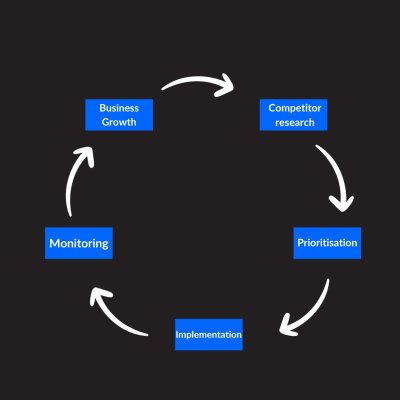
You know what you want to achieve with your marketing efforts, and you have your business targets in place. But you haven’t started conducting competitor research yet.
Competitor research is vital when it comes to business growth. A deep understanding of your competitive landscape in terms of brand awareness, product offering, and marketing activity can help you better understand where to put your own focus in your business.

Leveraging your competitor research will help drive business growth. This is especially true in the world of e-commerce, where innovation occurs often. Conducting competitor research allows you to identify opportunities, refine your strategy, and in some cases outperform your key competitors.
In this article, we will delve into some key areas to conduct research, and how you can use your research to drive business growth.
Market trends and innovations
Your customers will be driving product evolutions based on specific feature demands. Your competitors (especially the larger ones with seemingly infinite budgets) will be looking to capitalise on these.
Therefore, staying abreast of market trends and innovations is vital. Especially because supply chains have become more efficient, and innovations occur more frequently.
Understanding how your competitors are innovating their own products and leaning into customer demand and requests will help you evolve your own products.
You should be thinking about competitive product research on a quarterly basis at a minimum, to understand new product launches that your competitors have done.
Understanding new product strengths and weaknesses compared to your own product offering will be key to how you position and sell your existing products, as well as how you innovate your future products to satisfy customer demand.
GET IN TOUCH WITH OUR EXPERT TEAM TODAY TO FIND OUT HOW WE CAN HELP.
Product and pricing analysis
While your competitors are driving product innovation, they will also be looking to do this as cheaply as possible without compromising on product quality. They will want to do this to keep the end pricing as low as possible for customers.
This is why doing competitive product and pricing research is vital for your business. Understanding product offering, quality and pricing strategy are all elements in fully understanding your competitors’ products. This information will allow you to determine whether you can match or beat their prices while maintaining profitability.
The information will also allow you to tweak and improve your product quality over time. Equally, you’ll be able to determine how to differentiate your product from competitors. There may be certain features that competitors don’t offer but that could be advantageous for your customers (this is where market research also comes in handy).
Finally, you can find information on how your competitors are creating offers or bundling products. This will help you sell your products more efficiently if you know competitors have certain offers or bundles at a specific time of the year, for instance.
In order to easily conduct a product and pricing analysis of your competitors versus your own products, you could build a scorecard. This will easily help you determine a) where your competitors are stronger or weaker than you, and b) why this might be.
Customer reviews and feedback
If you are feeling unsure of how to improve and update your products, remember this: your customers need to be at the forefront of everything you do.
We mentioned market trends and innovation research above, which includes customer reviews and feedback on your products and those of your competitors. This information can come in handy to identify common customer pain points and struggles.
Positive reviews can prove useful when it comes to understanding product/market fit. These reviews will also help your team double down in terms of marketing and product evolution efforts.
However, it is equally important to address negative reviews and proactively look to solve customer complaints. Great customer service is often what brings customers back to a brand. Great customer service also creates brand advocacy.
It is really important to ensure your product and sales team have a close working relationship and keep each other informed of customer feedback. This two-way communication will help both improve the product and sell it.
Marketing competitor research
Marketing competitor research can be overwhelming as there is so much information to consider. The best place to start is your highest revenue-driving channel. This is where you’ll find the lowest-hanging fruit in terms of quick wins.
Some helpful areas to consider when it comes to your marketing competitor analysis are:
SEO competitor analysis
When it comes to your SEO competitor analysis, we would recommend using the keyword research you have conducted for your own business to determine where your competitors are ranking in comparison to you. From here, you can inform your own content gap analysis to get an understanding of the content that your competitors have published, that you’re currently missing.
You might also consider running a competitive technical review to understand the setup of your top competitors’ websites. In order to help you conduct this piece of research, it makes sense to set up a scorecard so that you can easily compare your own performance against your competitors.
Finally, you will need to conduct a competitive backlink analysis to highlight potential links you can acquire for your own business.
The best way to do this is to use a tool such as Ahrefs to pull out the backlink profiles from your competitors and your own. With this information, you can remove any duplicate root domains between your profile and theirs, and easily understand where they have gotten high-quality backlinks from and you have not.
This will help you capitalise on their efforts and also streamline your focus in terms of initial low-hanging fruit.
Paid media competitor analysis
When it comes to analysing your competitors’ paid media activity, it makes sense to look at all platforms. The Facebook Ads Library is a great place to start when it comes to paid social, and understanding the messaging and ad creatives that your competitors are using. The library offers a lot of information around this, so make use of it when you can.
The other key platform to review is Google Ads. Again, reviewing the ad copy and understanding which ad formats your competitors are using can help you identify where to start testing budgets. You can also use Google’s keyword planner to review competitor keywords by plugging in your competitors’ domains. It won’t give you everything, but it will give you some ideas.
Finally, it makes sense to review your competitors’ paid media landing pages. Are they simply sending traffic to on-site category/product pages, or do they have specific landing pages that are designed to more easily convert users into customers? Understanding their customer journey through their website can help you determine the type of journey to test on your own site.
Remember: A/B testing with paid media is relatively important to help you get an understanding of what works best for your own business. Test ad copy, creatives, and landing page journeys to determine what converts the best.
Organic social media competitor analysis
Organic social media can be a powerful tool to create brand loyalty and advocacy. Many brands become frustrated with this channel as it doesn’t lead to immediate conversions, but tends to be more of a nurturing channel that can also be used for brand awareness.
Ask yourself these questions when conducting a competitive social media analysis:
- What content are my competitors pushing out across social?
- Are they using these platforms for brand awareness or customer support?
- Which platforms do they use the most to do this?
- How are they engaging with customers/users on these platforms?
- What are their engagement levels?
In summary…
As with any activity, monitoring and adaptation is just as important when it comes to competitor research. It makes sense to keep abreast of competitor updates and new product releases. Continually updating your competitive scorecards can help you easily stay in the loop on changes in competitor activity.
And don’t forget to prioritise any changes you’re looking to make within your own business, based on competitor activity. There is so much information out there, it’s easy to get overwhelmed with the amount of updates you could be making. Prioritisation will help you focus on business growth more clearly.
LET’S CONNECT
If you would like to keep up to date with our latest news, resources, and more then subscribe to our mailing list here




